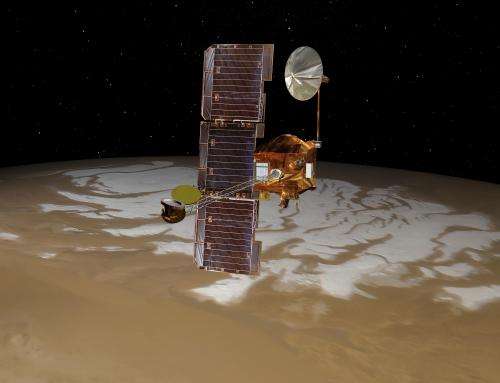Mars longevity champ switching computers

(Phys.org)—NASA's Mars Odyssey orbiter, already the longest-working spacecraft ever sent to Mars, will switch to some fresh, redundant equipment next week that has not been used since before launch in 2001.
Like many spacecraft, this orbiter carries a pair of redundant main computers, so that a backup is available if one fails. Odyssey's "A-side" computer and "B-side" computer each have several other redundant subsystems linked to just that computer. The Odyssey team has decided to switch to the B-side computer to begin using the B-side's inertial measurement unit. This gyroscope-containing mechanism senses changes in the spacecraft's orientation, providing important information for control of pointing the antenna, solar arrays and instruments.
"We have been on the A side for more than 11 years. Everything on the A side still works, but the inertial measurement unit on that side has been showing signs of wearing out," said Odyssey Mission Manager Chris Potts at NASA's Jet Propulsion Laboratory, Pasadena, Calif. "We will swap to the B side on Nov. 5 so that we still have some life available in reserve on the A side."
In many potential problem situations, the Odyssey's autonomous fault-protection response would switch the spacecraft from the active side to the other side. By preserving the capability of switching back to a fully functional A side, the mission continues to have the available protection of switching sides temporarily and correcting any fixable anomaly on the B side.
"The spare inertial measurement unit is factory new, last operated on the day before launch," Potts said.
Odyssey launched April 7, 2001, began orbiting Mars on Oct. 24 of that year, began systematic science observations of Mars in early 2002, and broke the previous record for longest-working Mars spacecraft in December 2010.
The side swap on Nov. 5 will intentionally put Odyssey into a reduced-activity status called "safe mode." As the team and the spacecraft verify all systems can operate well over the following several days, the orbiter will return to full operations, conducting its own science observations, as well as serving as a communications relay for NASA's active Mars rovers Opportunity and Curiosity.
The Mars Reconnaissance Orbiter, which shares the data relay return responsibility for the rovers at Mars, will carry the full burden of relay support for both rovers—Opportunity and Curiosity—during Odyssey's side-swap period. There will be a reduction in the total amount of relay data returned from Mars. The rover teams will reduce the amount of data planned for downlinking until Odyssey returns to full capacity after the side swap is complete, and will maintain near-normal tactical operations in the interim.
Odyssey's longevity enables continued science, including the monitoring of seasonal changes on Mars from year to year, and continued communication-relay service.
Provided by JPL/NASA




















